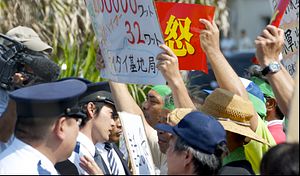Japanese Defense Minister Itsunori Onodera has been an exceptionally busy man this week, which coincides with U.S. President Barack Obama’s state visit to Tokyo. On April 19, Onodera oversaw the groundbreaking ceremony for a new military base and radar installation on Yonaguni Island, Japan’s westernmost territory, only 110 kilometers from Taiwan and the closest inhabited spot to the Senkaku/Diaoyu islands, hotly disputed by China and Japan.
Onodera’s attendance at the groundbreaking was delayed by thirty minutes as 70 protestors jostled with security personnel to block the minister’s vehicle. The Yonaguni base will be the first expansion of Japan’s military footprint in more than forty years. In his speech at Yonaguni, Onodera also suggested the possibility of Japan creating additional bases on its southwest islands, which lie closest to China.
The next day at Naha Air Base on the island of Okinawa, Onodera launched a new squadron of four E-2C Hawkeye airborne early warning aircraft to increase surveillance of the skies between China and Japan’s southern islands, which include the disputed Senkakus/Diaoyus. Underscoring the need for the new squadron, the Ministry of Defense reported earlier this month that in the twelve-month period ending March 2014, it had scrambled fighter jets in response to Chinese aircraft approaching Japan’s airspace a record 415 times, up from 306 in the prior twelve months. The ministry said “many” of the Chinese aircraft were fighter jets.
Throughout the week the Ministry has had to respond to repeated incursions by Chinese ships not only in the area of the Senkaku/Diaoyu islands, but closer, near Japan’s diminutive Kume Island, which lies 80 kilometers from Japan’s militarily critical island of Okinawa. Japanese news reports described a Chinese oceanographic research ship dropping a tethered device into the sea near Kume, which marks the eastern limit of the Miyako strait, one of the few channels through the “first chain of islands” surrounding China that China’s navy can use to transit away from its coastline and into the Pacific Ocean. It is also a preferred route for the People’s Liberation Army Navy to move its submarines into the Pacific.
On the west side of the strait, Miyako Island itself hosts a Japan Self Defense Forces radar installation, to monitor traffic through the strait and provide other forms of electronic intelligence. In November of 2013, Japan’s military positioned on Miyako for the first time Type-88 surface-to-ship missiles for what were described as “temporary” exercises. The missiles have the range to target surface vessels anywhere within the Miyako Strait.
The missile exercises coincided with a Rand report that suggested the U.S. and its allies use land-based anti-ship missiles at choke-points in the Asia-Pacific region to restrict movements of China’s navy in the event of conflict. China’s Communist Party-affiliated Global Times newspaper declared on its front page that Japan’s transfer of the missiles to Miyako was “an unprecedented move that experts say is targeted at blocking the Chinese navy.”
Quite apart from positioning missiles and radar to counter China, Defense Minister Onodera’s scrambling this week has another dimension. Three days after his Yonaguni scuffle with anti-base protestors, 149 Japanese government representatives paid memorial visits to Tokyo’s Yasukuni shrine, a flashpoint for Chinese and Korean outrage because it honors Class-A war criminals from the Second World War, as well as 2.5 million Japanese war dead. This visit occurred the day before Obama arrived in Tokyo, part of a trip intended to bolster U.S. support of its allies in Asia. Indeed, the day after he arrived in Tokyo, Obama for the first time stated unequivocally that the hot-button Senkaku Islands “are administered by Japan and therefore fall within the scope of Article 5 of the U.S.-Japan Treaty of Mutual Cooperation and Security. And we oppose any unilateral attempts to undermine Japan’s administration of these islands.”
With that statement Obama came through for Japan on this occasion, but the continuing Yasukuni shrine debacle and the sentiments it conveys work against the U.S.-Japan alliance vis-à-vis China. Onodera may well be fighting hard to create a bulwark against Beijing, but his comrades in the Shinzo Abe government seem to be fighting equally hard to create an image of 1930s Japan, which offers their country no security.
Victor Robert Lee reports on the Asia-Pacific region and is the author of the espionage novel Performance Anomalies (2013, Perimeter Six Press).


































